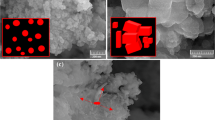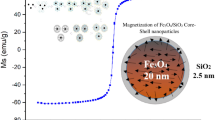Abstract
Water-soluble magnetite nanocrystals have been prepared by one-step non-alkoxide sol-gel method. The magnetic properties of magnetite nanocrystals obtained are size dependent. The experimental results also reveal that 2-pyrrolidone not only serves as solvent, but also involves surface coordination which renders the magnetite nanoparticles water-soluble and colloidal solution stable. Although the current synthetic approach is a small modification to the non-alkoxide sol-gel method, it allows us to directly obtain high-quality water-soluble magnetic nanocrystals. In addition, we realize that this method could be easily extended to preparation of many other transition and main group metal oxide water-soluble nanocrystals only from simple metal ion salts.
Similar content being viewed by others
References
Mornet S, Vasseur S, Grasset F, et al. Magnetic nanoparticle design for medical diagnosis and therapy. J Mater Chem, 2004, 14: 2161–2175
Corot C, Robert P, Idee J M, et al. Recent advances in iron oxide nanocrystal technology for medical imaging. Adv Drug Delivery Rev, 2006, 58: 1471–1504
Palma R D, Peeters S, Van Bael M J, et al. Silane ligand exchange to make hydrophobic superparamagnetic nanoparticles water-dispersible. Chem Mater, 2007, 19: 1821–1831
Lee J H, Huh Y M, Jun Y W, et al. Artificially engineered magnetic nanoparticles for ultra-sensitive molecular imaging. Nat Med, 2006, 13: 95–99
Nam J M, Thaxton C S, Mirkin C A. Nanoparticle-based bio-bar codes for the ultrasensitive detection of proteins. Science, 2003, 301: 1884–1886
Biddlecombe G B, Gun’ko Y K, Kelly J M, et al. Preparation of magnetic nanoparticles and their assemblies using a new Fe(II) alkoxide precursor. J Mater Chem, 2001, 11: 2937–2939
Zhou Z H, Wang J, Liu X, et al. Synthesis of Fe3O4 nanoparticles from emulsions. J Mater Chem, 2001, 11: 1704–1709
Lin C R, Chu Y M, Wang S C. Magnetic properties of magnetite nanoparticles prepared by mechanochemical reaction. Mater Lett, 2006, 60: 447–450
Fan R, Chen X H, Gui Z, et al. A new simple hydrothermal preparation of nanocrystalline magnetite Fe3O4. Mater Res Bull, 2001, 36: 497–502
Balasubramaniam C, Khollam Y B, Banerjee I, et al. DC thermal arc-plasma preparation of nanometric and stoichiometric spherical magnetite(Fe3O4) powders. Mater Lett, 2004, 58: 3958–3962
Gash A E, Satcher J H, Simpson R L, et al. Use of epoxides in the Sol-Gel synthesis of porous iron(III) oxide monoliths from Fe(III) salts. Chem Mater, 2003, 15: 3268–3275
Long J W, Logan M S, Carpenter E E, et al. Synthesis and characterization of Mn-FeOx aerogels with magnetic properties. J Non-Cryst Solids, 2004, 350: 182–188
Qi H Z, Yan B, Lu W, et al. A non-alkoxide Sol-Gel method for the preparation of magnetite (Fe3O4) nanoparticles. Curr Nanosci, 2011, 7: 381–388
Sun S H, Zeng H, Robinson D B, et al. Monodisperse MFe2O4 (M =Fe, Co, Mn) nanoparticles. J Am Chem Soc, 2004, 126: 273–279
Yu H, Gibbons P C, Kelton K F, et al. Heterogeneous seeded growth: A potentially general synthesis of monodisperse metallic nanoparticles. J Am Chem Soc, 2001, 123: 9198–9199
Watzky M A, Finke R G. Transition metal nanocluster formation kinetic and mechanistic studies. A new mechanism when hydrogen is the reductant: Slow, continuous nucleation and fast autocatalytic surface growth. J Am Chem Soc, 1997, 119: 10382–10400
Klug H P, Alexander L E. X-ray Diffraction Procedures for Polycrystalline and Amorphous Materials. New York: John Wiley & Sons, 1962. 491–538
Lopez-Quintela M A, Rivas J. Chemical reaction in microemulsions: A powerful method to obtain ultra fine particles. J Colloid Inter Face Sci, 1993, 158: 446–451
Lee Y, Lee J, Bae C J, et al. Large-scale synthesis of uniform and crystalline magnetite nanoparticles using reverse micelles as nanoreactors under reflux conditions. Adv Funct Mater, 2005, 15: 503–509
Li Z, Sun Q, Gao M. Preparation of water-soluble magnetite nanocrystals from hydrated ferric salts in 2-Pyrrolidone: Mechanism leading to Fe3O4. Angew Chem Int Ed, 2005, 44: 123–126
Li Z, Chen H, Bao H, et al. One-pot reaction to synthesize water-soluble magnetite nanocrystals. Chem Mater, 2004, 16: 1391–393
Author information
Authors and Affiliations
Corresponding author
Rights and permissions
About this article
Cite this article
Qi, H., Yan, B., Li, C. et al. Synthesis and characterization of water-soluble magnetite nanocrystals via one-step sol-gel pathway. Sci. China Phys. Mech. Astron. 54, 1239–1243 (2011). https://doi.org/10.1007/s11433-011-4375-0
Received:
Accepted:
Published:
Issue Date:
DOI: https://doi.org/10.1007/s11433-011-4375-0




